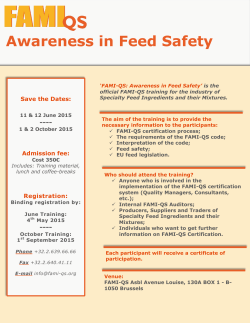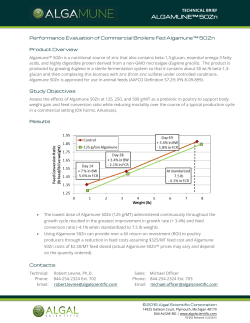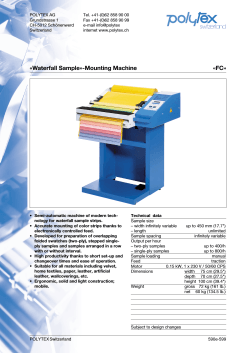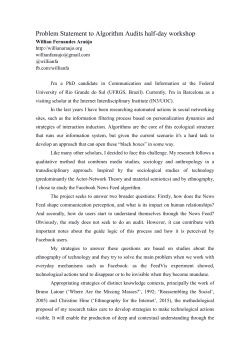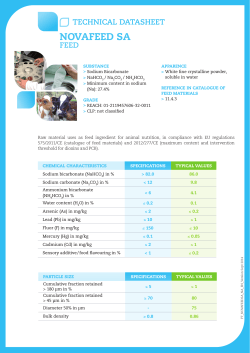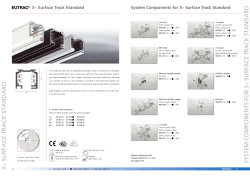
View/Open
Report 14/2015 • Published March 2015 Feed intake in Atlantic salmon fed with two different spreading patterns of feed A CREATE project Turid Synnøve Aas, Trine Ytrestøyl, Torbjørn Åsgård, Kristoffer Rist Skøien, Morten Omholt Alver and Jo Arve Alfredsen Nofima is a business oriented research institute working in research and development for aquaculture, fisheries and food industry in Norway. Company contact information: Tel: +47 77 62 90 00 E-mail: post@nofima.no Internet: www.nofima.no Nofima has about 350 employees. Business reg.no.: NO 989 278 835 VAT The main office is located in Tromsø, and the research divisions are located in Bergen, Stavanger, Sunndalsøra, Tromsø and Ås. Main office in Tromsø: Muninbakken 9–13 P.O.box 6122 Langnes NO-9291 Tromsø Ås: Osloveien 1 P.O.box 210 NO-1431 ÅS Stavanger: Måltidets hus, Richard Johnsensgate 4 P.O.box 8034 NO-4068 Stavanger Bergen: Kjerreidviken 16 P.O.box 1425 Oasen NO-5828 Bergen Sunndalsøra: Sjølseng NO-6600 Sunndalsøra Report Title: Feed intake in Atlantic salmon fed with two different spreading patterns of feed Author(s)/Project manager: ISBN: 978-82-8296-279-7 (printed) ISBN: 978-82-8296-280-3 (pdf) ISSN 1890-579X Report No.: 14/2015 Accessibility: Open Date: Turid Synnøve Aas, Trine Ytrestøyl, Torbjørn Åsgård, Kristoffer Rist Skøien, Morten Omholt Alver and Jo Arve Alfredsen Department: 20 March 2015 Nutrition and feed technology Client: 13 Client's ref.: SINTEF Fiskeri og havbruk AS Keywords: Arne Fredheim Project No.: Feed spreading; Feed intake; Feeding behaviour Summary/recommendation: 2424 Number of pages and appendixes: Atlantic salmon with initial body weight 0.6 kg kept in 3.3 m3 tanks was fed one meal daily, either by dropping the feed from one point, or by spreading the feed over the water surface, for one month. The relative feed intake (% of body weight per day) in salmon fed without spreading or with spreading of the feed was 0.63±0.05 and 0.64±0.02 %, respectively. The growth rate was identical in salmon fed without or with spreading of the feed, and no difference in variance in final weight was found. Fin damage was given a score at termination of the trial as a measure of competitive behaviour during feeding. No difference in fin damage for salmon fed without or with spreading of the feed was revealed. In conclusion, the data show that for the conditions used in the trial, spreading of feed had no influence on feed intake or growth of salmon. Summary/recommendation in Norwegian: Atlantisk laks med startvekt 0.6 kg ble fôret ett måltid daglig i en måned, der fôret ble gitt enten fra ett punkt, eller ved spredning på vannoverflaten. Det relative fôrinntaket (% av kroppsvekt per dag) hos laks som ble fôret uten eller med spredning av fôret på vannoverflaten var henholdsvis 0.63±0.05 and 0.64±0.02 %. Vekstraten var identisk for laks som ble fôret uten eller med spredning av fôret på vannoverflaten, og det ble ikke funnet noen forskjell i variasjon i sluttvekt. Finneskade ble evaluert med et scoringssystem ved avslutning av forsøket som et mål på aggresjon under måltidene. Det ble ikke funnet noen forskjell i finneskade hos laks som fikk fôr uten eller med spredning av fôret. Det kan konkluderes med at under de betingelsene som ble brukt i forsøket, hadde spredning av fôret ingen betydning for fôrinntak eller vekst hos laks. Table of Contents 1 Introduction ............................................................................................................... 1 2 Materials and methods .............................................................................................. 2 2.1 2.2 2.3 2.4 2.5 Fish trial .................................................................................................................................. 2 Sampling ................................................................................................................................. 5 Measurement of physical feed quality ................................................................................... 5 Calculations ............................................................................................................................ 5 Statistical analysis ................................................................................................................... 6 3 Results ....................................................................................................................... 7 4 Discussion ................................................................................................................ 10 5 References ............................................................................................................... 13 1 Introduction In salmon farming, feed is commonly spread over a large area of the cage assuming that this makes the feed available to a large number of the fish in the cage, which again will be beneficial for feed intake and growth. The feed is usually transported to the cages with a pneumatic system where the feed is carried by air through a pipe system, and a spreader is mounted on the outlet of the pipe. Spreading of the pellets can be controlled by adjusting the air stream in the system (Oehme et al., 2012). However, air stream is a main factor for pellet breakage in the feeding system (Aas et al., 2011), and thus, with regard to losses due to pellet breakage, moderate spreading of feed is advantageous. Feed loss also occurs when uneaten feed sink to the bottom of the cage, or drift sideways out of the cage. Clearly, good feeding routines produce minimal feed spill. However, loss also occurs in the form of reduced feed utilization and growth. As feed utilization in salmon is highest at high feed intake (Einen et al., 1995; Einen et al., 1999; Grisdale-Helland et al., 2013), some overfeeding may be necessary to achieve maximum feed intake and feed utilization. Thus, optimal feeding routines in salmon farming imply minimal pellet breakage and minimal feed spill while maximal feed intake is assured. At fish farms, control of feeding is assisted by camera systems. Models intending to optimize feeding are also derived (Alver et al., 2004; Alver et al., 2015). Spreading of feed across the surface is assumed to increase feed intake in fish by making feed available to all individuals and minimize hierarchical behavior during feeding. The manner of feed dispersal influences the equality of access of feed among individuals (reviewed by Attia et al., 2012). At restricted feeding, the aggression level may be high (Cañon Jones et al., 2010), and localized feeding may result in larger growth variation among individuals than when feed is dispersed. Growth and aggression levels related to feed dispersion in large scale sea cages is poorly documented. As spreading is correlated to pellet breakage, such information is crucial in order to optimize feeding routines. In the present study therefore, feed intake was measured in Atlantic salmon fed either from one point over the tank with no spreading on the water surface, or the feed was spread over a large area of the water surface. 1 2 Materials and methods 2.1 Fish trial A tank experiment with Atlantic salmon with mean start weight 607 g was run from November 11th to December 11th 2014 with approximately 100 fish per tank. The fish trial was run in triplicate in octahedral (quadratic with the corners ‘cut’) tanks (2x2 m and volume 3.3 m3) supplied with sea water (salinity 32 ‰) in a flow through system at the Nofima’s research facilities at Sunndalsøra (Fig. 1). The average water temperature was 11.0 °C (SD 1.6, range 7.5-13.4 °C, logged every 5 min) and the fish was kept at continuous light. Figure 1 The salmon was kept in 3.3m3 tanks. Each tank was covered with a net to prevent fish from jumping out of the tank. The feed was distributed with Poro EX 04 automatic feeders (Poro AB, Kåge, Sweden). For tanks with spreading of the feed on the surface, a Poro EX 06 spreader was connected to the feeder. For tanks without spreading of the feed on the water surface, the spreader was dismounted, so that the feed fell into the water from the opening of the feeding automat (Fig. 2). Figure 2 The daily ration was placed in the container of the feeding automat. Left: The spreader used to spread the feed over the water surface in the tank. Right: In tanks without feed spreading, the spreader was dismounted and the feed dropped into the water from the outlet of the feeding device. 2 Prior to the trial, the tanks were standardized with regard to water flow (80 L/min), water velocity and spreading of feed. The water current was measured in all tanks just below the feeder, 40 cm from the tank wall and at 30 cm depth. The overall mean current was 23 cm/sec (Table 1). In the three tanks with spreading of the feed, each spreader was manually adjusted so that a largest possible area of the tank was covered, but without throwing pellets out of the tank. Table 1 Water current (cm/sec) measured below the feeder, 40 cm from the tank wall and at 30 cm depth. Data are given as mean and SD (n=10). No spreading Tank Water current, cm/sec Spreading 208 209 214 207 213 215 22 SD=4 23 SD=3 23 SD=3 24 SD=6 23 SD=3 23 SD=2 As pellets landed on the water surface, they started to sink and followed the circular water current until they landed on the tank bottom (Fig. 3). During this movement through the water volume, the feed was available for the fish. After some circular movements on the tank bottom, the pellets followed the water flow out of the outlet in the center in the bottom of the tank. The spreading of pellets in time was measured by running the feeding system for 3 sec in one tank without and one tank with spreader, with no fish in the tanks. The time (sec) it took from start of feeding to the first and the last pellet reached the bottom of the tank was recorded (n=10; Table 2). The difference between first and last pellets, which express the time the feed was in the water column, was 12 and 15 sec in a tank without and with spreading, respectively. The difference was not significant (P<0.05) with ANOVA. 3 Table 2 Time (sec) from start of feeding till first and last pellet reached the tank bottom, and the difference, at 3 sec feeding in one tank without and one tank with spreading and with no fish in the tank. Data are given as mean and SD (n=10). Without spreading (Tank 208) With spreading (Tank 207) First pellet 7 SD=1 7 SD=1 Last pellet 19 SD=5 22 SD=4 Difference 12 SD=4 15 SD=5 Figure 3 The left image is from a tank with no spreading of feed. Pellets can be seen entering the tank from the left side under the feeder and settling on the bottom. The right image is from a tank with a spreader. Pellets are more distributed in the water column compared to without spreader. The salmon was fed a commercial feed with pellet size 4.5 mm (Skretting Supreme, Skretting, Stavanger, Norway). The physical properties of the feed are shown in Table 3. The fish was fed one meal daily, lasting from 9 to 10 AM. All tanks were fed the same amount of feed, and the size of the ration was adjusted daily based on the last three day’s feed intake aiming at 20 % overfeeding in the tanks with highest feed intake. The uneaten feed was collected at approximately 10:30 AM, and the feed intake estimated according to Helland et al (1996). Briefly, the uneaten feed was collected and weighed, and dry matter measured. The recovery (%) of uneaten feed was estimated by following the same routine as in the trial, but with no fish in the tanks. The recovery value was used to correct the amount of uneaten feed, and daily feed intake was calculated as feed given minus corrected uneaten feed. The recovery was measured for both spreading and no spreading of feed, but there was no significant difference in recovery values between the two treatments, and therefore, the overall mean value of recovery was used for both treatments. Table 3 Pellet length and diameter, bulk density and sinking velocity of the feed used in the trial (Mean ± SD). Physical properties of the feed Pellet diameter (mm) 4.6 ± 0.3 (n=20) Pellet length (mm) 7.5 ± 1.0 (n=20) Bulk density (g/L) 650 ± 2.1 (n=3) Sinking velocity (sec/m) 11.2 ± 0.9 (n=20) 4 2.2 Sampling At start and end of the trial, biomass was recorded and the fish counted. At termination of the trial, the individual weight of 30 fish from each tank was also registered. The fin damage of these 30 fish was evaluated by a scoring system where dorsal, caudal, pelvic and pectoral fins (Fig. 4) were given an integer score from 0 (no visible damage) to 4 (severe damage), and damages were classified as fin erosion, split fin, deformed fin, hemorrhage or asymmetric fins. At handling and weighing, the fish was sedated with Aqui-S® (clove oil, isoeugenol 2-5 mg/L). Dorsal fin Pectoral fins Figure 4 Caudal fin Pelvic fins The dorsal, caudal, pectoral and pelvic fins were examined for fin damage. 2.3 Measurement of physical feed quality Diameter and length of the pellets were measured with an electronic caliper. Bulk density was measured by loosely pouring the feed from a funnel into a 1 000 ml measuring cylinder. Sinking velocity was measured in a 1.3 m high cylinder with tight bottom and filled with 34 ‰ salt water at 10 °C, and start and end of 1 m distance marked on the outside. The time the pellets used for sinking 1 m was recorded for one pellet at a time. 2.4 Calculations Feed intake was estimated according to Helland et al. (1996). Feed intake (DM basis) Feed fed (g, DM) - Waste feed (g, DM) Recovery , where Feedspill(g,DM) , estimated by following the experimental feeding routines, but with no Feedused(g,DM) fish in the tanks. Recovery 5 Weightincrease(%) 100 Finalweight(g) - Startweight(g) Startweight(g) Relative feed intake (% of body weight per day) 100 Specificgrowthrate(SGR,%) Feed intake (g, DM) Start weight (g) Final weight (g) Days fed 2 100 [ln(finalweight)- ln(Startweight)] Days fed Thermalgrowthcoefficient (TGC) 1000 1 3 1 3 Finalweight - Startweight Sumdaydegrees 2.5 Statistical analysis Unless otherwise specified, data are given as mean±S.E.M. Tank data were analyzed with one-way ANOVA, which is equivalent to t-test when only two treatments are compared. Individual data were compared with a hierarchical (nested) ANOVA using the ‘Nested’ procedure in SAS. The score data (individual data) were also analyzed with a nested ANOVA after arcsine transformation of the score data divided by 4 (to obtain data in the range 0-1, as the scale of scoring was 0-4). ANOVA of original data and transformed data gave corresponding results. A significance level of α=0.05 was used for all statistical analyses. Statistical analyses were performed with the SAS 9.4 computer software (SAS Institute Inc, Cary, USA). 6 3 Results There was no mortality in the trial and the fish appeared to be at good health. The total feed intake in the trial was 132±10 and 127±1 g (dry matter) per individual in salmon fed without or with spreading of the feed, respectively (Table 4). Calculated as feed (‘as is’) eaten per tank, the feed intake in salmon fed without or with spreading of the feed was 14.2±1.5 and 14.1±0.3 kg, respectively (Fig. 5). 15 14 13 Cumultative feed inakte, kg 'as is' per tank 12 11 10 9 8 7 6 5 4 3 2 With spreading 1 Without spreading 0 0 1 2 3 4 5 6 7 8 9 10 11 12 13 14 15 16 17 18 19 20 21 22 23 24 25 26 27 28 29 Day Figure 5 Cumulative feed intake (kg feed ‘as is’ per tank) in Atlantic salmon fed without or with spreading of the feed on the water surface (mean, n=3). The growth was identical in Atlantic salmon fed either without or with spreading of the feed on the water surface (Table 4). The SGR in both treatment groups was 0.97 %, and the TGC was 2.6 in both treatment groups. 7 Table 4 Body weight, growth and feed intake in Atlantic salmon fed without or with spreading of the feed on the water surface. Data are given as mean±SEM (n=3). Without spreading With spreading Initial body weight, g 618±4 596±17 Final body weight, g 818±15 789±19 Individual weight gain, g 201±14 193±6 Weight gain, % 32.5±2.2 32.5±1.3 SGR, % per day 0.97±0.06 0.97±0.03 TGC 2.6±0.2 2.6±0.1 Feed intake, g per individual, dry matter 132±10 127±1 0.63±0.05 0.64±0.02 Relative feed intake, % of body weight per day Comparing the body weight of 30 individual fish with from each tank with a nested ANOVA did neither indicate any effect of spreading the feed (Table 5). The variation in final body weight among groups was measured as the standard deviation. These standard deviations of body weight data were compared with ANOVA, and no significant difference in variation between the two groups were found (Table 5). Table 5 Body weight of 30 randomly selected individuals from each tank of Atlantic salmon fed without or with spreading of the feed on the water surface. Body weight was analyzed with nested ANOVA, while variance in body weight was compared analyzing SD with a one-way ANOVA. No significant differences were found. Without spreading With spreading Tank 208 209 214 207 213 215 Mean weight, g 782 771 851 779 765 806 SD 207 188 197 163 148 210 Maximum, g 1132 1358 1289 1052 1255 1436 Minimum, g 464 409 498 412 479 306 No significant effect of spreading the feed was found on scoring of fin damage (Table 6). The damage on the dorsal fins was mainly fin erosion and some split fins and deformed fins. The damage on the caudal fins was also mainly classified as fin erosion, but some split fins and hemorrhages were also present. For pectoral fins, split fins were the most common damage, followed by fin erosion and hemorrhage. For pelvic fins, there was very little damage except some split fins. In one tank (tank 215, with spreading of feed), several fish had hemorrhages and red spots in the skin. The reason for this is unknown. In the other tanks, the fish generally appeared normal for salmon of this size kept in tanks. 8 Table 6 Scoring of fin damage in 30 randomly selected individuals from each tank of Atlantic salmon fed without or with spreading of the feed on the water surface. Damage of each fin was given a score from 0 (no visible damage) to 4 (severe damage). Data are given as mean±S.E.M., where S.E.M is calculated from the pooled standard deviation of data from all individuals (n=90) within each treatment. Data were analyzed with ANOVA, hierarchical model. No significant effect of treatment was found. Without spreading With spreading Dorsal fin 2.0 ± 0.1 1.8 ± 0.1 Caudal fin 1.8 ± 0.1 1.7 ± 0.1 Pectoral fins 1.6 ± 0.1 1.5 ± 0.1 Pelvic fins 0.6 ± 0.1 0.5 ± 0.1 9 4 Discussion A tank experiment was chosen to test whether spreading of the feed affects feed intake in Atlantic salmon. Compared to experiments in sea cages, tank experiments has the advantages that feed intake and growth can be measured with high accuracy, and it can be run at a relatively low cost. However, data from small scale studies are not necessarily valid for large scale conditions. As for all trials, the data from the present study is only representative for the conditions used in this study. There were large difference in spreading pattern on the water surface depending on whether the feed was spread or not, which represents spreading in space. However, feed is also spread in time, and the feed is available for the salmon while sinking through the water. Numerically, spreading of the feed on the water surface resulted in a longer time in the water (Table 2), although this was not significantly different (P<0.05) from the time the pellets were in the water when feeding from one point. There was some variation in these measurements as all pellets follow different routes through the water column. Besides, there is a difference among pellets in sinking velocity (Skøien et al., in prep). Thus, the 10 replicates did not reveal any significant difference in spreading in time (Fig. 6). Figure 6 Spreading of pellets in time in the water volume when feed was distributed without (left, denoted ‘point’) or with (right, denoted ‘spreader’) spreading of feed. Spreading is given as the difference in time (sec) from the first pellet reached the bottom of the tank to the last pellet reach the bottom after 3 sec feeding (n=10). The box length represent the difference between the 25 and 75 percentile, the dot in the box shows the mean, the horizontal line the median, whereas minimum and maximum values are indicated with the vertical lines extending from the box. 10 The overall mean SGR was 0.97 % per day, which is in accordance with (Austreng et al., 1987) or just below (Skretting, 2012) expected growth of salmon of this size at this temperature. According to Skretting (2012), Atlantic salmon of 600 and 800 g are expected to grow 1.28 and 1.14 % per day, respectively, at 11 °C. A period of one or two weeks for acclimation to new conditions is normal in salmon trials. This was also seen in the present trial, where the feed intake was moderate, but gradually increasing, during the first ten days. Thereafter, the feed intake was as expected, and the overall growth in the trial was only slightly below expected values. It can therefore be assumed that the feed intake and growth was at normal levels during the last 20 days of the trial, and that the data are representative. The feed intake was very similar in both treatment groups, showing that in this trial, spreading of the feed on the water surface did not affect the mean feed intake in salmon. Spreading the feed on the water surface is generally believed to reduce variance in feed intake and correspondingly, body weight, in fish (Attia et al., 2012; Ryer and Olla, 1996). This is assumed to be due to that feeding from one point may favor the most dominant individuals whereas when spreading the feed, it is available to all individuals. The variation in individual body weight when salmon was fed without spreading versus with spreading the feed was measured by comparing the standard deviations. An ANOVA of these standard deviations did not indicate any effect of spreading of the feed on variation in final body weight. The individual body weight at start was not measured because this require extra handling of the fish, which imply extra stress to the fish, which again may lead to reduced feed intake in the trial. The variation in body weight was assumed to equal in both treatment groups at start. The salmon was fed full ration in the present trial, whereas at restricted feeding, competitive behavior may result in larger differences in feed intake when the fish is fed without spreading of feed than when the feed is spread (Ryer and Olla, 1996). The trial was not designed as a growth trial. To reveal significant effects of growth in salmon, a doubling in weight during the experiment is often used as a rule of thumb. In the present trial, the growth was 32.5 %. However, since the growth was exactly the same in both treatment groups, it can be concluded that spreading of the feed did not affect growth. The scoring of fin damage was used as a measure of hierarchical, aggressive behavior in the tanks. With the two feeding patterns used in the present trial, no differences in score of fin damage were found. Spatially concentrated feed delivery is believed to increase competition (Symons, 1971) but this effect may not be seen due to the overfeeding in the present study. This, together with feed intake and body weight data, indicate that there is no call for using the feed spreader on these units if feed is sufficiently available. As all handling and spreading of feed increases the risk of pellet breakage (Aas et al., 2011), the feed should rather be distributed from one point, without the spreader. In a sea cage with circumference 150 m or more and variable wind and water current, the effect of spreading versus no spreading of feed may be different from the data obtained in a tank experiment. However, since feed pellets are prone to breaking upon spreading (Aas et al., 2011) the feed should not be spread needlessly. To optimize feeding routines, it is therefore necessary to measure the effect of spreading the feed in large-scale sea cages also. 11 Conclusion No significant differences in feed intake or growth were found in salmon fed from one point or feed spread over the water surface in 3.3 m3 experimental tanks. Neither was there any effect of spreading of the feed on variation in body weight, or in fin damage. In the present trial thus, spreading the feed on the water surface did not improve any of the measured parameters compared to feed feeding the fish from one point. Acknowledgements The authors sincerely wish to thank all who has contributed to this work. The staff at Nofima’s research facilities at Sunndalsøra, and especially Frode Nerland, is acknowledged for running the fish trial, and Roger Selset for technical advice. The study was funded by the Centre for Research-based Innovation in Aquaculture Technology (CREATE). 12 5 References Aas, T.S., Oehme, M., He, G., Sørensen, M., Lygren, I., Åsgård, T., 2011. Analysis of pellet degradation of extruded high energy fish feeds with different physical qualities in a pneumatic feeding system. Aquacult.Eng. 44, 25-34. Alver, M.O., Alfredsen, J.A., Sigholt, T., 2004. Dynamic modelling of pellet distribution in Atlantic salmon (Salmo salar L.) cages. Aquacultural Engineering 31, 51-72. Alver, M.O., Føre, M., Skøien, K.R., Aas, T.S., Oehme, M., Alfredsen, J.A., 2015. Modelling and optimization of feed distribution in sea cages. In prep. Attia, J., Millot, S., Di-Poï, C., Bégout, M.L., Noble, C., Sanchez-Vazquez, F.J., Terova, G., Saroglia, M., Damsgård, B., 2012. Demand feeding and welfare in farmed fish. Fish Physiol. Biochem. 38, 107-118. Austreng, E., Storebakken, T., Åsgård, T., 1987. Growth rate estimates for cultured Atlantic salmon and rainbow trout. Aquaculture 60, 157-160. Cañon Jones, H.A., Hansen, L.A., Noble, C., Damsgård, B., Broom, D.M., Pearce, G.P., 2010. Social network analysis of behavioural interactions influencing fin damage development in Atlantic salmon (Salmo salar) during feed-restriction. Appl. Anim. Behav. Sci. 127, 139-151. Einen, O., Holmefjord, I., Åsgård, T., Talbot, C., 1995. Auditing nutrient discharges from fish farms: theoretical and practical considerations. Aquacult. Res. 26, 701-713. Einen, O., Mørkøre, T., Thomassen, M.S., 1999. Feed ration prior to slaughter - a potential tool for managing product quality of Atlantic salmon (Salmo salar). Aquaculture 178, 149-169. Grisdale-Helland, B., Lemme, A., Helland, S.J., 2013. Threonine requirement for maintenance and efficiency of utilization for threonine accretion in Atlantic salmon smolts determined using increasing ration levels. Aquaculture 372–375, 158-166. Helland, S.J., Grisdale-Helland, B., Nerland, S., 1996. A simple method for the measurement of daily feed intake of groups of fish in tanks. Aquaculture 139, 157-163. Oehme, M., Aas, T.S., Sørensen, M., Lygren, I., Åsgård, T., 2012. Feed pellet distribution in a sea cage using pneumatic feeding system with rotor spreader. Aquacult.Eng. 51, 44-52. Ryer, C.H., Olla, B.L., 1996. Growth depensation and aggression in laboratory reared coho salmon: the effect of food distribution and ration size. Journal of Fish Biology 48, 686-694. Skretting, 2012. Fôr, p. 75 pp. http://www.skretting.no/Internet/SkrettingNorway/ webInternet.nsf/wPrId/A4C6CF0C453D3750C1257A700023CC92!OpenDocument. Accessed January 2015. Symons, P.E.K., 1971. Behavioural adjustment of population density to available food by juvenile Atlantic salmon. J. Anim. Ecol. 40, 18. 13 ISBN 978-82-8296-279-7 (printed) ISBN 978-82-8296-280-3 (pdf) ISSN 1890-579X
© Copyright 2025
